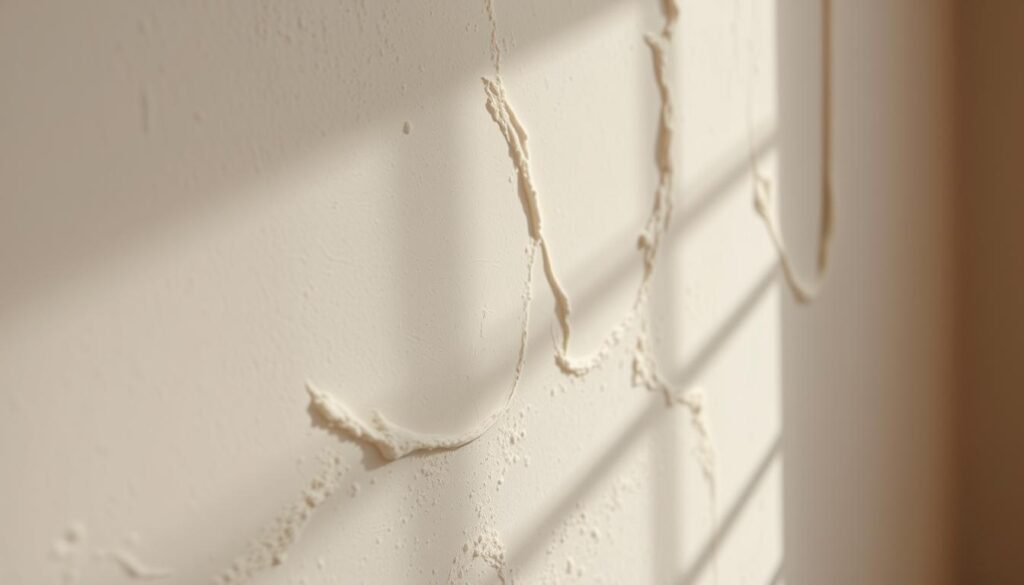Ever wondered why your freshly plastered wall seems dry to the touch but still feels damp underneath? Understanding the drying process of plaster is crucial for achieving a flawless finish. While it may appear dry within hours, the reality is more nuanced. Plaster drying involves two key stages: touch-dry and fully cured. Each stage requires patience to avoid issues like cracking or paint flaking later on.
Factors such as thickness, temperature, and humidity play a significant role in drying times. For instance, thinner layers dry faster than thicker ones, and higher temperatures can speed up the process1. However, rushing the process can lead to problems like shrinkage or brittleness, especially in hot weather2. On the other hand, cold weather may extend drying times but allows for better curing2.
If you’re unsure about the drying stages or need advice, don’t hesitate to contact Kent Plasterers. We’re here to help you achieve the best results for your project.
Key Takeaways
- Plaster drying involves touch-dry and fully cured stages.
- Thinner layers dry faster than thicker ones1.
- Higher temperatures and lower humidity reduce drying time1.
- Rushing the process can cause cracking or paint flaking.
- Cold weather extends drying times but improves curing2.
- For expert advice, contact Kent Plasterers.
Understanding the Plaster Drying Process
Plastering a wall involves more than just applying a smooth finish; it’s a meticulous process that requires attention to detail. Whether you’re working on a small repair or a large project, understanding the stages from application to drying is essential for achieving a professional result.
Overview of Plaster Application
The plastering process typically begins with an undercoat, which provides a solid base for the finishing layer. Each layer has distinct setting and curing times, influenced by factors like material type and environmental conditions3. For instance, thicker applications may take longer to dry compared to thinner ones4.
Once the undercoat is applied, a finishing plaster is added to create a smooth, even surface. This stage is crucial for achieving the desired aesthetic and ensuring the wall is ready for paint or other decorative finishes. Handling new plaster with care is vital, as it remains delicate during the initial drying phase.
Stages from Application to Drying
From the moment plaster is applied, it undergoes several stages before it’s considered fully dry. Initially, the surface may appear ready for decorating, but this is often just the touch-dry stage. Curing, which ensures the plaster reaches its full strength, continues beneath the surface5.
Ambient temperature and humidity levels play a significant role in this process. For example, ideal conditions include a temperature range of 18 to 25 degrees Celsius and humidity levels around 60-70%3. These factors help ensure even drying and prevent issues like cracking or brittleness.
If you’re unsure about any stage of the plastering process, our team at Kent Plasterers is here to provide expert advice. We’ll guide you through each step to ensure your project is a success.
Factors Influencing Drying Time
The drying process of plaster is influenced by several key factors. Understanding these elements can help ensure a smooth and durable finish. From environmental conditions to material choices, each factor plays a crucial role in determining how quickly plaster dries.
Temperature and Humidity Considerations
Ambient temperature and humidity significantly impact drying times. Warmer conditions, ideally between 18 to 25 degrees Celsius, promote faster curing6. Conversely, cold weather can slow down the process, potentially weakening the plaster’s strength6.
High humidity levels also extend drying times, as damp air retains moisture. Using dehumidifiers or fans can help manage this, ensuring even drying and preventing issues like cracking7.
Impact of Plaster Type and Wall Surface
The type of plaster used affects drying times. For instance, gypsum-based plasters dry quicker than lime-based ones due to their moisture retention properties8. Similarly, the wall surface—whether plasterboard or masonry—can influence overall drying time6.
Trapped moisture can lead to problems like cracking, especially in thicker applications. Applying thin coats and ensuring proper ventilation can mitigate these risks7.
“Proper management of drying conditions is essential for achieving a flawless plaster finish.”
If you’re unsure about managing these factors, our team at Kent Plasterers is here to assist. We provide expert advice to ensure your project achieves the best results.
how long does plaster take to dry
Drying times for plaster can vary significantly depending on the room’s conditions. Factors such as size, airflow, and ambient warmth all contribute to how quickly or slowly the material sets. For instance, a small patch repair may cure within a day, while an entire wall could take several weeks9.
In colder environments, drying can extend up to a month, especially if humidity levels are high10. Proper ventilation and maintaining a temperature between 18 to 25 degrees Celsius can help regulate this process11. Rooms with poor airflow or excessive moisture may require additional measures, such as dehumidifiers, to ensure even drying.
Variations in Drying Times by Room Conditions
The type of plaster and its application thickness also influence drying durations. Thicker layers, often referred to as long plaster applications, naturally take more time to dry compared to thinner coats10. For example, multi-finish plaster typically dries within 1-1.5 hours, but curing can take up to 10 days11.
Checking for a uniform pale pink colour is a reliable method to confirm that the new plaster is ready for the next stage9. Rushing this process can lead to issues like cracking or uneven surfaces, so patience is essential.
“Proper room conditions are crucial for achieving a flawless plaster finish.”
If you’re unsure about how room conditions might affect your project, don’t hesitate to contact Kent Plasterers. We’re here to provide expert advice tailored to your specific needs.
Practical Tips for Faster Drying
Speeding up the drying process of newly plastered walls requires careful attention to environmental factors. While it’s tempting to rush, improper methods can lead to issues like cracks or uneven surfaces. Here’s how to achieve optimal results safely.
Effective Use of Heating and Ventilation
Proper ventilation is essential for reducing drying time. Opening windows can increase airflow, but avoid overusing heating methods. Excessive heat can cause the plaster to dry too quickly, leading to cracks12.
Maintaining a room temperature between 18 to 25 degrees Celsius is ideal for even drying9. In colder months, portable heaters on a low setting can help, but avoid direct heat on the plaster13.
“Gentle heating and proper airflow are key to achieving a flawless finish without compromising the plaster’s integrity.”
Avoiding Common Pitfalls
Overusing dehumidifiers can remove too much moisture, causing the plaster to become brittle12. Instead, use them moderately in high-humidity environments. Ensure the plaster is uniformly dry before applying paint to prevent flaking13.
If you’re unsure about the process, consulting a professional plasterer can save time and ensure quality results. Their expertise can help avoid common mistakes and achieve a durable finish.
Best Practices Summary
| Tip | Benefit |
|---|---|
| Use gentle heating | Prevents rapid drying and cracks |
| Ensure proper ventilation | Reduces drying time evenly |
| Check for uniform dryness | Ensures better adhesion for paint |
| Consult a plasterer | Provides expert advice and solutions |
For further guidance or professional assistance, don’t hesitate to contact Kent Plasterers. We’re here to help you achieve the best results for your project.
Conclusion
Achieving a flawless finish on a plastered wall requires patience and attention to detail. As we’ve explored, the drying process depends on factors like temperature, humidity, and the type of plaster used. Waiting until the surface is completely dry—indicated by a uniform pale pink colour—is essential before applying paint or a mist coat11.
Rushing this stage can lead to issues like cracking or flaking. Each project varies, so it’s important to monitor the wall closely and ensure optimal conditions for drying. For new plaster, this often means waiting at least a week, though thicker layers may require more time14.
If you’re unsure about the process or need personalised advice, our team at Kent Plasterers is here to help. We’ll guide you through every step to ensure your project achieves the best results. For further queries, don’t hesitate to contact us.

